Dear Zazie, Here is today’s Lovers’ Chronicle from Mac Tag dedicated to his muse. How does your heart break? Rhett
The Lovers’ Chronicle
Dear Muse,
thrill runs through me
with you i feel vulnerable
fear disappearin’, lettin’ go
cannot control myself
the consummation
with you has come
revived, no longer hurtin’
pour yourself into me
i await my fill
i wake not from a dream
my hand finds yours
the dawn awaits
© Copyright 2020 mac tag/cowboy coleridge all rights reserved
where choice begins…
bewildered
every damn time
ever after came undone
each time goin’ in
i just knew
i was seein’ clearly
but i could never
remember
seemed like,
when the choices began,
then the paradise
and the innocence
would disappear
so if nothin’ else
i can say this
at last
choosin’ wisely
and livin’ this vision
is the culmination
of what had to be
now i can see
i remember
and i know
that we were
and are
of each other
© copyright 2018 mac tag/cowboy coleridge all rights reserved
for Sheli…
no doubt
the mistake of a life
leavin’ her standin’ there
in the High Plains sun
a kiss and a promise
that could not be kept
a see ya later
that damn near turned
into never see again
i was full of myself
and certain that i knew
what i wanted,
to make it in the big city
she fell in with a sonuvabitch
who damn near killed her
she is married now
to a good guy and happy
and i am glad
but here i sit
holdin’ back,
and chokin’ back
regret with every breath
© copyright 2017 mac tag/cowboy Coleridge all rights reserved
from this moment,
i am hooked
our eyes lock
i walk up
and say hello
i know not much
only this;
you are a rare one
in a you state of mind
the totem spins…
we are in Madrid
we drink too much
we have amazin’ sex
we go back to the cafes
and drink more wine
we git married by Goya
he was showin’ us
the Black Paintin’s
when I woke up
hard to think since then
you are the only true
had things been different
maybe it is the dream
maybe it is the wine;
mind in a flurry
are we of each other
© copyright 2016 Mac tag/cowboy Coleridge all rights reserved
I was immediately inspired by yesterday’s Poem of the Day, so I began workin’ on my own version of “Roses and Rue”. I find that old poems provide fine inspiration to write lyrics. So here are the lyrics of the day:
A Poet’s Heartbreak
Could we get back what was lost,
Were it worth the cost,
Could we re-learn love’s song,
Bein’ apart so long
Could the past that is fled
Call back its dead,
Could we sing the old refrain,
Were it worth the pain
I remember we used to meet
At our favorite place to eat,
And you said each pretty word
In a way I had not heard
And your voice had a quaver in it,
As if it would quit,
And shook, in your lovely throat
With its last note
And your eyes, they were bright
Like stars at night,
And they did not resist
When I leaned and kissed
And your mouth, it would smile
For a long, long while,
Then spread all over with laughter
For minutes after
You were never afraid of a shower,
You would never cower:
I remember you ran and danced
Naked when the rain advanced
I remember I could not catch you,
No one could match you,
You looked wonderful,
And I watched in wonder, full
I remember your hair gleamin’
In the rain streamin’
That day on the beach
When everything was in our reach
I remember so well the room,
Where our passion came abloom
The night for the first time
Our bodies moved in rhyme
And the look on your face,
When we reached that place,
Where hearts and flesh entwine
And everything is fine
And the handkerchief of French lace
Which you held to your face
Had a small tear left a stain
Or was it the rain
In your eyes as you waved adieu
Was a look full of rue
In your voice as it said good-bye
Was a petulant cry
“You have only wasted your time.”
That was my selfish crime
Then I rushed through the gate
But it was all too late
Could we get back what was lost,
Were it worth the cost,
Could the past that is fled
Call back its dead
That is a poet’s heartbreak,
Dear love, for your sake,
In rhythm and rhyme and much ado,
In roses and rue
But strange that I was not told
That the brain can hold
In a tiny ivory cell
God’s heaven and hell
That is a poet’s heartbreak,
Dear love, for your sake,
In rhythm and rhyme and much ado,
In roses and rue
The Song of the Day is “Heartbreak Warfare” by John Mayer.
On this day in 1771 – Premiere in Milan of the opera Ascanio in Alba, composed by Wolfgang Amadeus Mozart, age 15.
| Ascanio in Alba | |
|---|---|
| Opera by W. A. Mozart | |

The composer in 1777, by an unknown painter |
|
Ascanio in Alba, K. 111, is a pastoral opera in two parts (Festa teatrale in due atti) by Mozart to an Italian libretto by Giuseppe Parini. It was commissioned by the Empress Maria Theresa.
Synopsis
- Place: the site of the future city of Alba Longa, near Rome
Act 1
The opening scene introduces Venus and Ascanio, the son she had by Aeneas. The goddess discusses the charms of Alba and invites her son to go and rule there. She urges him not to reveal his identity to Silvia, a nymph to whom he is betrothed, but to introduce himself to her under a false identity to test her virtue. While shepherds summon their promised ruler, Fauno reveals that the smiling face of Aceste, a priest, is a sign that the day will be a day of supreme happiness. Obeying the goddess, Ascanio pretends to be a foreigner attracted by the beauties of the place. Aceste tells the shepherds that their valley will be the site of a fine city and that they will have a sovereign, Ascanio, before the day is out. He also informs Silvia that she will be Ascanio’s bride, but she replies that she is in love with a young man she has seen in a dream. The priest reassures her, saying the young man in her dream can be none other than Ascanio. Venus then appears to Ascanio and asks him to test the girl a little longer before revealing his true identity.
Act 2
Ascanio spots Silvia among the shepherds and tries to talk to her. The girl immediately recognizes the young man from her dreams. Fauno intervenes and suggests to “the foreigner” (Ascanio) that he should go off and announce the building of Alba in foreign parts. Thus convinced that the foreigner is not Ascanio, Silvia is deeply saddened. She finally decides to accept her fate but declares she never will love anyone else than Ascanio.
Aceste consoles Silvia, saying that her tribulations are about to come to an end. Venus is invoked by a magnificent chorus. Silvia and Ascanio add their voices to the chorus and the goddess descends on her chariot surrounded by clouds. Venus unites the two lovers and explains how she had intended her son to discover the virtue of his fiancée. Aceste pronounces an oath of fidelity and loyalty to Venus, who then retires. It only remains for Ascanio to perpetuate the race of Aeneas and guide the city of Alba to prosperity.
Today is the birthday of Adolphe-Félix Cals (17 October 1810 – 3 October 1880 Honfleur); portrait, genre, and landscape painter.
Gallery

self-portrait (1851)
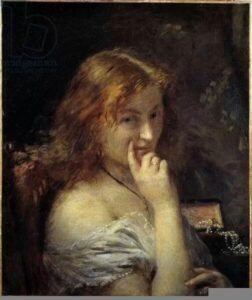

A sunday in Saint-Siméon, 1876

Sundown at Honfleur (1875)
| Childe Hassam | |
|---|---|
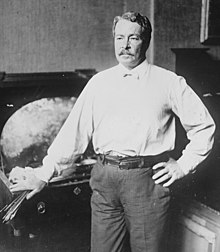
|
|
Today is the birthday of Frederick Childe Hassam (Boston; October 17, 1859 – August 27, 1935 East Hampton, New York); Impressionist painter, noted for his urban and coastal scenes. Along with Mary Cassatt and John Henry Twachtman, Hassam was instrumental in promulgating Impressionism to American collectors, dealers, and museums. He produced over 3,000 paintings, oils, watercolors, etchings, and lithographs over the course of his career, and was an influential American artist of the early 20th century.
In February 1884, Hassam married Kathleen Maude (or Maud) Doane (born 1861), a family friend whom he had courted for several years. Throughout their life together, she ran the household, arranged travel, and attended to other domestic tasks, but little is known about their private life. Although he had shown steady improvement in his oil painting, before letting go of illustration Hassam decided to return to Paris with his wife. Hassam’s success with illustration was sufficient, that in 1886 the couple were able to engage a well-located apartment/studio with a maid near the Place Pigalle, the center of the Parisian art community. The couple returned to the United States in 1889, taking residence in New York City.
Gallery
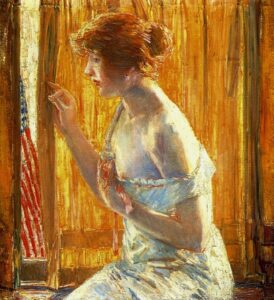

View in Montmartre, Paris, 1889, Princeton University Art Museum
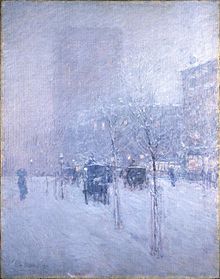
Late Afternoon, New York, Winter, c. 1900. Brooklyn Museum
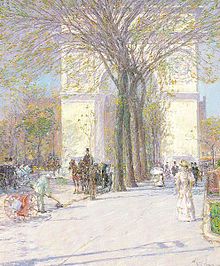
Washington Arch, in Washington Square Park, c. 1893

Rainy Day, Boston (1885), Toledo Museum of Art in Ohio

Celia Thaxter’s Garden, 1890, The Metropolitan Museum of Art, New York City

Celia Thaxter in her Garden, 1892, Smithsonian Institution

Church at Old Lyme, oil on canvas, Childe Hassam, 1905

Snowstorm, Madison Square, c. 1890

August Afternoon, Appledore, 1900
![]()
Mt. Beacon at Newburgh, 1916

The Water Garden, c. 1909

The Avenue in the Rain, oil on canvas, 1917. The White House
-
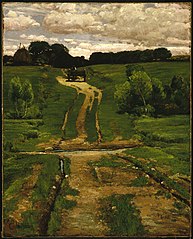
A Back Road, Brooklyn Museum
-
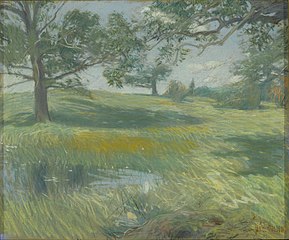
Meadows, Brooklyn Museum
-

Montauk, Brooklyn Museum
-

The Gorge, Appledore, Brooklyn Museum
-

The Victorian Chair
-

Summer Sunlight
-

Improvisation
-

April – (The Green Gown)
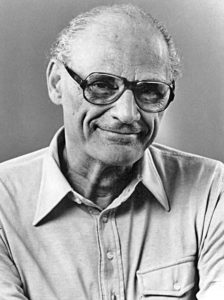 Today is the birthday of Arthur Miller (Arthur Asher Miller; Harlem; October 17, 1915 – February 10, 2005 Roxbury, Connecticut); playwright, essayist, and a major figure in the twentieth-century American theater. Among his most popular plays are All My Sons (1947), Death of a Salesman (1949), The Crucible (1953) and A View from the Bridge (1955, revised 1956). He also wrote several screenplays and was most noted for his work on The Misfits (1961).
Today is the birthday of Arthur Miller (Arthur Asher Miller; Harlem; October 17, 1915 – February 10, 2005 Roxbury, Connecticut); playwright, essayist, and a major figure in the twentieth-century American theater. Among his most popular plays are All My Sons (1947), Death of a Salesman (1949), The Crucible (1953) and A View from the Bridge (1955, revised 1956). He also wrote several screenplays and was most noted for his work on The Misfits (1961).
Miller was often in the public eye, from the late 1940s till the early 1960s. During this time, he was awarded the Pulitzer Prize for Drama; testified before the House Un-American Activities Committee; and was married to Marilyn Monroe.
In 1940, Miller married Mary Grace Slattery.Miller was exempted from military service during World War II because of a high school football injury to his left kneecap. That same year his first play was produced; The Man Who Had All the Luck won the Theatre Guild’s National Award.

In June 1956, Miller left Slattery and married Monroe. They had met in 1951, had a brief affair, and remained in contact since. Monroe had just turned 30 when they married and, having never had a real family of her own, was eager to join the family of her new husband.
Monroe began to reconsider her career and the fact that trying to manage it made her feel helpless. She admitted to Miller, “I hate Hollywood. I don’t want it anymore. I want to live quietly in the country and just be there when you need me. I can’t fight for myself anymore.”
She converted to Judaism to “express her loyalty and get close to both Miller and his parents”, writes biographer Jeffrey Meyers. Monroe told her friend, Susan Strasberg: “I can identify with the Jews. Everybody’s always out to get them, no matter what they do, like me.” Soon after she converted, Egypt banned all of her movies.
Away from Hollywood and the culture of celebrity, Monroe’s life became more normal; she began cooking, keeping house and giving Miller more attention and affection than he had been used to.
Later that year, Miller was subpoenaed by the HUAC, and Monroe accompanied him. In her personal notes, she wrote about her worries during this period:
I am so concerned about protecting Arthur. I love him—and he is the only person—human being I have ever known that I could love not only as a man to which I am attracted to practically out of my senses—but he is the only person—as another human being that I trust as much as myself…
Miller began work on writing the screenplay for The Misfits in 1960, directed by John Huston and starring Monroe. But it was during the filming that Miller and Monroe’s relationship hit difficulties, and he later said that the filming was one of the lowest points in his life. Monroe was taking drugs to help her sleep and more drugs to help her wake up, which caused her to arrive on the set late and then have trouble remembering her lines.
Shortly before the film’s premiere in 1961, Miller and Monroe divorced after their five years of marriage. Nineteen months later, Monroe died of a likely drug overdose.
Miller later married photographer Inge Morath in February 1962. She had worked as a photographer documenting the production of The Misfits. Miller and Inge remained together until her death in 2002.

Miller died of bladder cancer and heart failure, at his home. He died on the evening of February 10, 2005 (the 56th anniversary of the Broadway debut of Death of a Salesman), aged 89, surrounded by Barley, family and friends. His body was interred at Roxbury Center Cemetery in Roxbury.
After the Fall (1964)
- Where choice begins, Paradise ends, innocence ends, for what is Paradise but the absence of any need to choose this action?
- Foreword
- I am bewildered by the death of love. And my responsibility for it.
- Quentin in After the Fall (1964) Act II
- I saw clearly only when I saw with love. Or can one ever remember love? It’s like trying to summon up the smell of roses in a cellar. You might see a rose, but never the perfume. And that’s the truth of roses, isn’t it? — The perfume?
- Quentin in After the Fall (1964) Act II
- I think it’s a mistake to ever look for hope outside of one’s self.
The Ride Down Mount Morgan (1991)
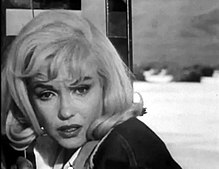
- I love her too, but our neuroses just don’t match.
- Lyman speaking of his wife to his lawyer, Act 1
- Maybe all one can do is hope to end up with the right regrets.
- Act 1
- Look, we’re all the same; a man is a fourteen-room house — in the bedroom he’s asleep with his intelligent wife, in the living-room he’s rolling around with some bareass girl, in the library he’s paying his taxes, in the yard he’s raising tomatoes, and in the cellar he’s making a bomb to blow it all up.
- Lyman, Act 2
Mac Tag
Follow us on twitter @cowboycoleridge.

No Comments on "The Lovers’ Almanac 17 October – of each other – premiere of Mozart’s Ascanio in Alba – art by Adolphe-Félix Cals & Childe Hassam – birth of Arthur Miller"